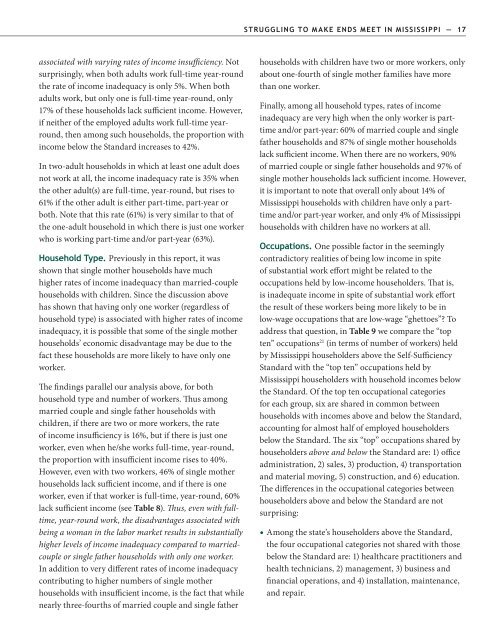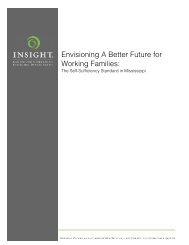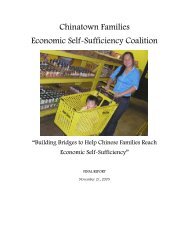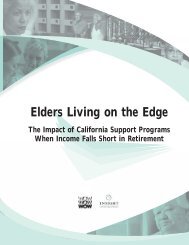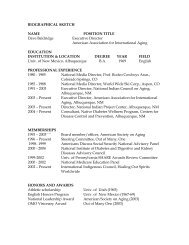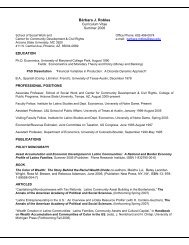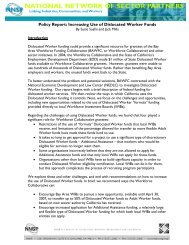Overlooked and Undercounted - Insight Center for Community ...
Overlooked and Undercounted - Insight Center for Community ...
Overlooked and Undercounted - Insight Center for Community ...
You also want an ePaper? Increase the reach of your titles
YUMPU automatically turns print PDFs into web optimized ePapers that Google loves.
STRUGGLING TO MAKE ENDS MEET IN MISSISSIPPI — 17<br />
associated with varying rates of income insufficiency. Not<br />
surprisingly, when both adults work full-time year-round<br />
the rate of income inadequacy is only 5%. When both<br />
adults work, but only one is full-time year-round, only<br />
17% of these households lack sufficient income. However,<br />
if neither of the employed adults work full-time yearround,<br />
then among such households, the proportion with<br />
income below the St<strong>and</strong>ard increases to 42%.<br />
In two-adult households in which at least one adult does<br />
not work at all, the income inadequacy rate is 35% when<br />
the other adult(s) are full-time, year-round, but rises to<br />
61% if the other adult is either part-time, part-year or<br />
both. Note that this rate (61%) is very similar to that of<br />
the one-adult household in which there is just one worker<br />
who is working part-time <strong>and</strong>/or part-year (63%).<br />
Household Type. Previously in this report, it was<br />
shown that single mother households have much<br />
higher rates of income inadequacy than married-couple<br />
households with children. Since the discussion above<br />
has shown that having only one worker (regardless of<br />
household type) is associated with higher rates of income<br />
inadequacy, it is possible that some of the single mother<br />
households’ economic disadvantage may be due to the<br />
fact these households are more likely to have only one<br />
worker.<br />
The findings parallel our analysis above, <strong>for</strong> both<br />
household type <strong>and</strong> number of workers. Thus among<br />
married couple <strong>and</strong> single father households with<br />
children, if there are two or more workers, the rate<br />
of income insufficiency is 16%, but if there is just one<br />
worker, even when he/she works full-time, year-round,<br />
the proportion with insufficient income rises to 40%.<br />
However, even with two workers, 46% of single mother<br />
households lack sufficient income, <strong>and</strong> if there is one<br />
worker, even if that worker is full-time, year-round, 60%<br />
lack sufficient income (see Table 8). Thus, even with fulltime,<br />
year-round work, the disadvantages associated with<br />
being a woman in the labor market results in substantially<br />
higher levels of income inadequacy compared to marriedcouple<br />
or single father households with only one worker.<br />
In addition to very different rates of income inadequacy<br />
contributing to higher numbers of single mother<br />
households with insufficient income, is the fact that while<br />
nearly three-fourths of married couple <strong>and</strong> single father<br />
households with children have two or more workers, only<br />
about one-fourth of single mother families have more<br />
than one worker.<br />
Finally, among all household types, rates of income<br />
inadequacy are very high when the only worker is parttime<br />
<strong>and</strong>/or part-year: 60% of married couple <strong>and</strong> single<br />
father households <strong>and</strong> 87% of single mother households<br />
lack sufficient income. When there are no workers, 90%<br />
of married couple or single father households <strong>and</strong> 97% of<br />
single mother households lack sufficient income. However,<br />
it is important to note that overall only about 14% of<br />
Mississippi households with children have only a parttime<br />
<strong>and</strong>/or part-year worker, <strong>and</strong> only 4% of Mississippi<br />
households with children have no workers at all.<br />
Occupations. One possible factor in the seemingly<br />
contradictory realities of being low income in spite<br />
of substantial work ef<strong>for</strong>t might be related to the<br />
occupations held by low-income householders. That is,<br />
is inadequate income in spite of substantial work ef<strong>for</strong>t<br />
the result of these workers being more likely to be in<br />
low-wage occupations that are low-wage “ghettoes”? To<br />
address that question, in Table 9 we compare the “top<br />
ten” occupations 21 (in terms of number of workers) held<br />
by Mississippi householders above the Self-Sufficiency<br />
St<strong>and</strong>ard with the “top ten” occupations held by<br />
Mississippi householders with household incomes below<br />
the St<strong>and</strong>ard. Of the top ten occupational categories<br />
<strong>for</strong> each group, six are shared in common between<br />
households with incomes above <strong>and</strong> below the St<strong>and</strong>ard,<br />
accounting <strong>for</strong> almost half of employed householders<br />
below the St<strong>and</strong>ard. The six “top” occupations shared by<br />
householders above <strong>and</strong> below the St<strong>and</strong>ard are: 1) office<br />
administration, 2) sales, 3) production, 4) transportation<br />
<strong>and</strong> material moving, 5) construction, <strong>and</strong> 6) education.<br />
The differences in the occupational categories between<br />
householders above <strong>and</strong> below the St<strong>and</strong>ard are not<br />
surprising:<br />
Among the state’s householders above the St<strong>and</strong>ard,<br />
the four occupational categories not shared with those<br />
below the St<strong>and</strong>ard are: 1) healthcare practitioners <strong>and</strong><br />
health technicians, 2) management, 3) business <strong>and</strong><br />
financial operations, <strong>and</strong> 4) installation, maintenance,<br />
<strong>and</strong> repair.


